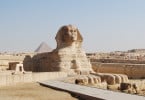And so scientists had to bring together clues as to how these magnificent monuments were constructed. Throughout the past two decades, a number of new findings and studies have enabled researchers to paint a clearer picture of these achievements.
Giza Pyramids
The first, and highest, the pyramid at Giza was constructed by Pharaoh Khufu (the reign began about 2551 B.C.). The pyramid, which is now 455 feet (138 meters) tall, is known as the “Great Pyramid” and was considered by ancient writers to be a wonder of the world.
The pyramid of Khafre (the reign started around 2520 B.C.) was only slightly smaller than Khufu’s, but it stood on higher ground. Many scholars believe that the monument to the Sphinx, which lies near the pyramid of Khafre, was built by Khafre, and that the face of the Sphinx was modeled after him.
The third pharaoh to build a pyramid at Giza was Menkaure (the reign began around 2490 B.C.) who opted for a smaller pyramid that was 215 feet (65 m ) tall.
Over the past two decades, researchers have made a variety of discoveries related to the pyramids, including a town constructed near the Menkaure Pyramid, a study showing how water would make the blocks easier to push and the papyrus found in the Red Sea.
This helped researchers to gain a better understanding of how the Giza pyramids were constructed. New findings add to the older knowledge gained over the last two centuries.
Building Techniques for Giza Pyramids
The techniques used to construct the pyramids of Giza have been built over the years, with all the challenges and failures that every modern-day scientist or engineer would face.
Pyramids originated from simple rectangular “mastaba” tombs, built in Egypt more than 5,000 years ago, according to the findings of the archaeologist Sir Flinders Petrie. A major advance occurred during the reign of Pharaoh Djoser (the reign started around 2630 B.C.). His mastaba tomb at Saqqara began as a simple rectangular tomb, before becoming a six-layer step pyramid with underground tunnels and chambers.
The pharaoh Snefru (reign began around 2575 B.C.) constructed at least three pyramids during his reign was another leap in pyramid construction technique. Instead of building step pyramids, Snefru’s architects developed methods for constructing smooth, true pyramids.
The architects of Snefru seemed to have been in trouble. One of the pyramids that he constructed on a Dahshur site is known today as ‘the bent pyramid’ as the angle of the pyramid partly shifts, giving it a bent look. In general, scholars consider the bent angle a result of a design defect.
It was a second pyramid at Dahshur, which is today known as the “red pyramid” — called by its color, so named “the red pyramid” — which has a continuous angle making it a true pyramid.
Snefru ‘s son, Khufu, would use the lessons of his father and his predecessors to build the “Great Pyramid” the largest pyramid in the world.
Planning the Pyramids
Pharaohs appointed a high-ranking official to oversee the construction of a pyramid. In 2010, a team of archaeologists discovered papyri dating back to the reign of Khufu at the site of Wadi al-Jarf in the Red Sea. Papyri ‘s text stated that, in the 27th year of Khufu ‘s reign, Pharaoh’s half-brother, Ankhaf, was the vizier (highest official to serve the King in ancient Egypt) and “chief of all the works of the King,” the archaeologists Pierre Tallet and Gregory Marouard wrote in Near Eastern Archaeology.
While the Papyri said that Ankhaf was in charge of Pharaoh’s 27th year, many scholars believe that it is possible that another person, possibly Vizier Hemiunu, was in charge of building a pyramid during the earlier part of Khufu ‘s reign.
Researchers are working to understand the sophisticated planning that would have involved building pyramids, which required the construction not only of pyramids but also of temples, boat pits, and cemeteries in the vicinity of enormous structures.
Researchers have noted that the Ancient Egyptians had the ability to align structures with the true north very precisely, something that might have helped in the planning of the pyramids. Glen Dash, an engineer who studies the pyramids at Giza as part of Ancient Egypt Research Associates (AERA), noted that Khufu’s pyramid is aligned to the true north in one-tenth of a degree. It’s not entirely clear how the ancient Egyptians did this.
Food Supply
Over the last few years, AERA archaeologists have been digging and studying a port in Giza that would have been used to bring supplies, food, and people. The papyri found at Wadi al-Jarf alludes to the importance of the ports of Giza, saying that the limestone blocks used in the outer shell of the pyramid were shipped from the quarries to the pyramid sites within a few days by ship transport.
The port that AERA archaeologists found is located in a town built near the pyramid of Menkaure. This town had large homes for high-ranking officials, a barracks complex that probably housed soldiers and buildings where a large number of clay seals (used for record-keeping) were found. Ordinary workers probably slept in simple dwellings near the pyramid site.
Estimates given by various archaeologists for the size of the Giza labor force tend to hover around 10,000 people in all three pyramids. These people have been well-fed, sufficient cattle, sheep, and goats were killed every day to produce an average of 4,000 pounds of meat to feed the pyramid builders.
Quarrying the blocks
Many of the stones used in Khufu ‘s pyramid come from a horseshoe-shaped quarry located just south of the pyramid, said Mark Lehner, an Egyptologist who leads AERA, and engineer David Goodman. In 1985, they published their findings in the journal Mitteilungen des Deutschen Archäologischen Instituts.
Construction workers would have used blocks from quarry south-southeast of Menkaure ‘s pyramid to build that pyramid, the researchers said. It is not clear, however, which quarry was used for the pyramid of Khafre.
When almost complete, each of the pyramids of Giza was furnished with a smooth outer case made of limestone. Little of this outer casing remains today, having been reused over the millennia for other construction projects in Egypt.
The papyri found at Wadi al-Jarf said that the limestone used in the casing had come from a quarry in Turah, near modern Cairo, and had been shipped to Giza by boat along the Nile River and a series of canals. It took four days for a boat trip, the papyri said.
Moving the blocks
The Ancient Egyptians would have used large sledges to move the stones across the land, which could be pushed or pulled by gangs of workers. The sand in front of the sledge was probably dampened by water, which reduced friction, making it easier to move the sledge, a team of physicists from the University of Amsterdam found in a study published in 2014 in the journal Physical Review Letters.
Most Egyptologists agree that when the stones arrived at the pyramids, a ramp system was used to lift the stones. However, Egyptologists are uncertain as to how these ramps were designed. Little evidence of the ramps survives, but over the last few decades, several hypothetical designs have been proposed.
New data may come from the Scan Pyramids Mission, an initiative undertaken by researchers at three different universities, the Heritage Innovation Preservation Institute and the Egyptian Ministry of Antiquities. The scientists of this project are in the process of scanning and rebuilding the pyramids of Giza using a variety of technologies. In addition to finding out more about the construction of the pyramids, the project may also reveal whether there are any uncovered chambers within the structures.
How long did it take to build the Great Pyramid?
Covering an area of 13 acres, the massive monument was designed to align with the compass points and built with an estimated 2,3 million stones, each of which weighs a ton or more on average. The workforce is thought to have consisted of thousands of skilled tradesmen and paid workers, as opposed to slaves, and estimates suggest that the project has taken some two decades to complete. It has been speculated that workers have created a ramp









